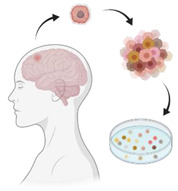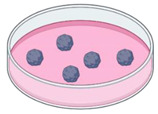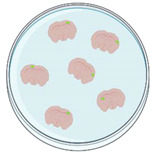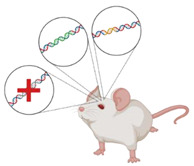Monolayer cell culture

|
|
Readily available resource Minimal cost Easy to use Allow rapid studies of biological properties of tumours Allow screening of multiple drug compounds
|
|
Neuro/tumoursphere culture

|
|
Preserve the complex individual level of genetic and epigenetic heterogeneity of the original tumour sample Maintain genetic stability over time Allow screening of multiple drug compounds
|
Represent just the cancer stem cell population of the original tumour 3D nature means that media nutrients are not equally distributed Generation depends on tumour grade and genetics Lack a realistic brain microenvironment composed by vessels and immune cells
|
Cerebral organoids

|
|
Recapitulates the variety of cerebral cell types Retain anatomical features of a simplified mammalian brain Allow studies of biological properties of tumours such as invasion, in a more physiological system compared to monolayer cultures
|
|
Organotypic brain slice culture

|
Maintain mouse brain slices in culture The genetic alteration can be introduced in the germline (knock-out, knock-in, transgenic models) or in the somatic cells (via viral-mediated gene delivery)
|
Maintains the in vivo brain architecture Allow faster studies of invasion ex vivo Drug screens can take place in a more realistic brain microenvironment
|
|
Genetically engineered mouse models

|
|
Genetic changes can be targeted to specific cell populations and induced at specific developmental stage of the animal Animals have an intact immune system Roles of individual mutations can be ascertained Tumour formation can be monitored from the very start
|
|
Xenograft mouse models

|
|
Closely resembles the original features of the tumour Heterogeneity is maintained Tumours generate their own vasculature
|
|
“Humanised” xenograft mouse models

|
|
|
|







